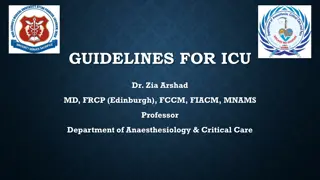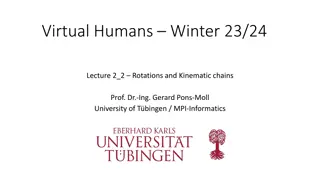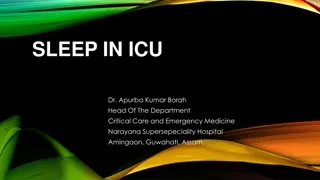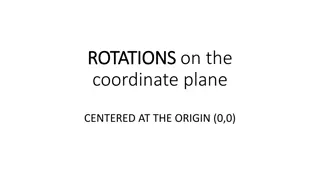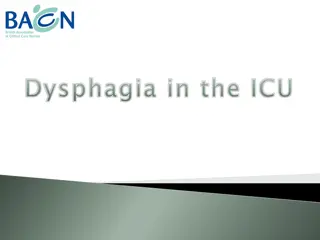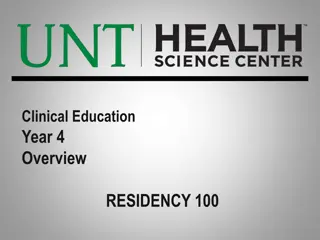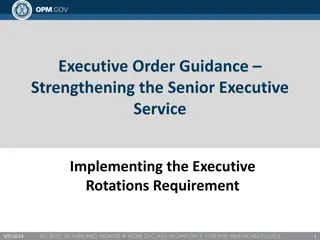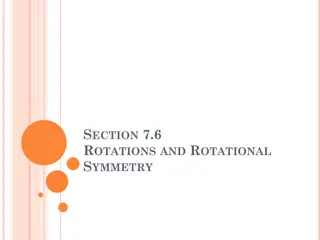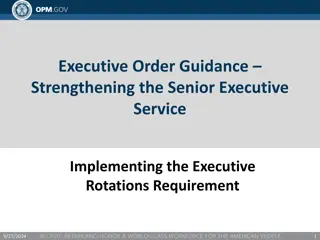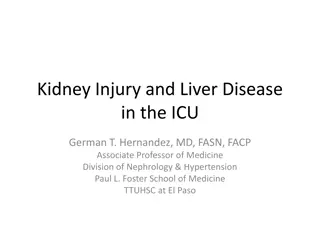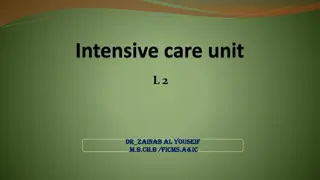Essential Tips for ICU Rotations
Prepare for your ICU rotation with these essential tips: read the orientation packet, educate yourself with original articles, prioritize patient stability, know your care team, and focus on learning and growth as an intern or resident. Be ready to identify sick patients, understand disease processes, and follow through with patient care. Avoid common pitfalls and stay proactive in your approach.
Uploaded on Sep 14, 2024 | 0 Views
Download Presentation

Please find below an Image/Link to download the presentation.
The content on the website is provided AS IS for your information and personal use only. It may not be sold, licensed, or shared on other websites without obtaining consent from the author.If you encounter any issues during the download, it is possible that the publisher has removed the file from their server.
You are allowed to download the files provided on this website for personal or commercial use, subject to the condition that they are used lawfully. All files are the property of their respective owners.
The content on the website is provided AS IS for your information and personal use only. It may not be sold, licensed, or shared on other websites without obtaining consent from the author.
E N D
Presentation Transcript
ICU Basics Anita Holtz, MD Southwest Pulmonary Associates July 24, 2017
Preamble Where to go ICU orientation packet Read before you come, read during the rotation Educate yourselves!! (This does not mean up to date everything) Educate Us!! *** Original articles*** Your knowledge should be evident in your own original note and ideally in your presentation Patient stability first, orders next, documentation last
Care team Nurses RTs Pharmacists Primary providers Techs Cleaning crew
What should I read? Marino ICU book Surviving sepsis trial Ardsnet protocol IDSA/ATS guidelines on pneumonia Any of the national guidelines for your patient's disease process
Expectations: Interns Recorders Be prepared, be honest, and prepare to work Learn to identify sick patients Put years of book work into disease processes Develop a problem list and learn how these diseases are treated Learn the guidelines Procedures Talking with patients and their families Follow through Learn how to consult Learn each other s patients
Expectations: Residents Evolve Be prepared, be honest, and prepare to work Learn to identify sick patients Develop a broad differential and learn how to answer questions Learn above the guidelines Educate your intern Judiciously order tests and learn from consultants Procedures Developed conversations with patients and their families Follow through Learn each other s patients
a) 25 year old runner comes into the ER after running a marathon. She is warm but no longer sweating, lethargic with HR 140s, RR 30s, BP 98/42 b) 68 yo M with CHF, COPD poorly controlled DM presents with a LLE wound that hot and crunchy. HR 110 Temp 101 BP 85/42 RR 18 c) 36 yo asthmatic who is awake, alert, anxious with RR 26 BP 140/90 HR 99 SPO2 100%. ABG 7.32/47/160 on 2L nc after 2 rounds of consecutive nebs d) 84 yo F with DM, alzheimers, CAD, bedbound who presents with foul smelling urine. Lethargic, BP 60/p, HR 130s IRIR, creatinine 4.2, troponin 2.9, bicarb 10
Pitfalls Dear Ms X, your mom is doing fine. Dear Ms X, you mom is stable Not telling primary team or surgeon / interventionist change in pt status Well there's no way to really know Making up data Not coming prepared, every day Not learning from your mistakes
Consultations You are internists first, even if you will only be here for a year Your job is to maximize your knowledge about the patient and disease management first Obvious immediate consults: acute abdomen, profound hyponatremia or anuria, STEMI, acute stroke, etc Know what the question is before you call. Onboard is not a question Have a well thought out differential. Call in a time appropriate manner Work with and learn from the consultant
Procedures Know the indications, alternatives and risks before consenting patient NEJM tutorials Obtain consent and materials Talk with your attending prior to the procedure
Code status Code status discussions should be a natural part of your H&P or consultations (much like that rectal or vaginal exam) As should be surrogate decision maker conversations
Code status Code status does not mean all care (including aggressive interventions) vs palliative care Patients and families are in shock. They need simple words they can digest. This may be the last memory they have of their loved one and what you say matters
Code status The conversation should never be phrased as do you everything to be done? Or to offer an A-la carte menu of possible interventions. Use the expression life support If you do not know enough about the patient s condition please politely excuse yourself from the conversation
Code status The primary objective is to know what the patient s wishes are. Your duty is to honor the patient s informed wishes (either directly obtained from the patient or vis a vis their surrogate) If the patient or family does not understand the gravity or complexity of their situation, kindly and compassionately explain to patient and family.
Code status It is absolutely ok and welcome to allow family s time to consider their options Please do not pressure the family. If you come to the conversation well prepared and you articulate your opinion clearly and with empathy and the family can t decide, leave them alone. Call a chaplain. Let them deliberate. Advise them if the patient looks grave or imminent to have family and friends to visit the patient
Code status Predictions: our inability to predict or not predict outcomes drives patient and family uncertainty. Prediction models DO exist. And yes some are better than others Like all things, we are doctors, scientists. We do not know the future. So sometimes we are wrong
Code status You job is not to change everyone to DNR In patients who are predicted to do poorly or die despite maximal medical interventions, a delicate conversation must be held with family There is NO ROLE for the breaking ribs conversation
End of life This is not the same as the code status question You will see people die. I did not write patients, I wrote people You will not feel good about this and we all need to acknowledge this This is someone else s worst day of their life and often the awake and interactive family member s second worst day of their life. Please remember this
End of life How far do we go? Well it depends on patient wishes and that depends on your understanding of how well they will do Sometimes it is a full court press until we hit an endpoint (resp failure, arrest) Sometimes it is defined as, do what you can that won t make mom or dad feel badly
End of life Withdrawal of support is not euthanasia Respect what the patient and their family would want Directing our efforts and energies from curing disease to treating the pain and anxiety at the end of life.
Resuscitation Early goal directed therapy- know the Nguyen, Rivers trial Hypovolemia dehydration How to resuscitate and with what R = 8 L/ r4 2 large bore ivs- (16 or 18 gauge) = short and fat = less resistance Triple lumen = 2 x 18g (depends on kit) + 1 x 20g PICC = 2 to 7Fr. 6Fr ~ 14g but 2 Fr ~ 22g and they are LONG Cordis: 9Fr IO: up to 5liters per hour
The IV menu 60% TBW is fluid, 2/3 fluid is intracellular, 1/3 extracellular, of extracellular fluid is extravascular Give liberally but most of what you give whatever you chose will go to extravascular space
IVF NS: 154 meq Na, 154 meq Cl, pH 5.7, 308 Osm NS: 77 meq Na, 77meq Cl LR: 130meq Na, 110 meq Cl, 28meq Lactate, 4meq K, 3meq Ca++, pH 6.4, 273 Osm Lactate converts to bicarb, avoid during transfusion (ca binding to citrate in blood prods) D5: 5% dextrose ~ 50gr Bicarb- 3amps in D5W (not in NS or NS) ~ 150 meq Na Normal Plasma: 140 Na, 103 Cl, 4 K, Ca 5, Mg 2, pH 7.4, 289 Osm
Colloid Albumin- 5% or 25%- do not give if hypovolemic 5% -20mmHg oncotic pressure (COP), life 16hrs 25% has 70mmHg oncotic pressure, expands plasma 4- 5x volume administered Can be given in acute liver injury, burns, with other blood products Hespan 6% starch 30mmHg onc pressure Dextran 6% and 10% (40mm Hg each) Blood products Colloid is expensive, no increase in mortality in using colloid, can worsen AKI, eventually leaches into the interstitium in distributive shock, coagulopathy- SAFE study 2004 NEJM, Cochrane review 2009, BMJ1998;316:961 Albumin may help in hypoalbuminemic patients (< 30 g/L) Crit Care Med. 2006 Oct;34(10):2536-40.
Vents 2 goals- oxygenation and ventilation AC vs IMV vs SIMV When to intubate? Hemodynamic instability/code (though no longer part of ACLS, so don t stop compressions for an airway) Hypoxemic respiratory failure Hypercapneic respiratory failure Status asthmaticus, copd that is tiring out Severe met acidemia airway protection - not everyone that is intoxicated needs an airway. Delirious people who are aspirating yes
Intubation Get everything ready first- call RT, notify the nurse and ask for sedation meds (below) have bag mask, nasal trumpet (key) or oral airway or LMA available just in case ETT- size 6 if nasal intub, typically want 7.5 (less optimal) or 8-0 ETT, inflate the balloon yourself and release it, +/- lubricant Suction, everyone forgets suction. Ck the laryngoscope- 3 or 4 MAC or Miller typically works Looking is free, touching will cost you Meds: you need an induction agent (etomidate, ketamine, propofol, versed, thiopental), +/- paralytic (rocuronium T 1.5hr, 4hr liver injury, 2.5h renal pt or vecuronium T 65-75 min). Do not use Sux in renal patients, hyperK, rhabdo or patients with neuromuscular disease Sniffing position except in RA (unstable occipito-atlanto join), neck fracture Know when to stop and let anesthesia go at it- prior h/o difficult intubation, large neck, can t see cords, patient quickly deteriorating
Vents Settings- assume AC Can set the following Vt ~ 8cc/kg up to 10cc/kg in normal person in acute failure, use IBW if morbidly obese. 6-8cc/kg if ARDS (use ARDS net protocol), asthma/copd 6-10cc/kg RR think minute ventilation (VE= Vt x RR). Normal 10- 16, COPD/asthma most important is leaving time to exhale so RR 10 -14 or VE= 10L/min, ARDS <35bpm FiO2 PEEP: normals 5, in hypoxemia depends on FiO2 (see ARDSnet), Asthma = 0, copd 0-3 I:E normally 1:2, can go 1:3 or longer (eg copd) Ck an ABG 1hr after adjusting the vent and every AM, also ck chest xr qAM Permissive hypercapnea is ok as long as the patient is oxygenating Do not try to normalize the ABG, your goals are 1) oxygenate, 2) maintain sufficient ventilation 3)decrease the work of breathing 4) synchrony
ABG <7.35 = acidemia, > 7.45 = alkalemia pH = [pCO2]/[HCO3]. For approp pH both pCO2 and HCO3 must move together to maintain pH balance Can have 3 disturbances, can never have concomitant resp alkalosis and resp acidosis acidemia vs alkalemia what is the primary disturbance (if acidemia, is the pCO2 high or is the bicarb low) Is there a compensation and is the compensation appropriate. If the compensation is not appropriate a 3rd disturbance exists 1. 2. 3.
ABG If the primary disturbance is acidemia: Primary respiratory, expect pH to decrease 0.08 for every 10mm Hg increase in pCO2. expect bicarb to acutely increase by 1 for each 10mm Hg increase or chronically increase by 3 for each 10 pCO2 Primary met acidemia. Ck for AG. If AGMA, then look for delta gap/NAGMA. Then look for respiratory compensation. Expect pCO2 to be 1.5 x [hco3] = 8 +/- 2 (winter s formula).
Hypoxemia Dyspnea hypoxemia 4 main causes of hypoxemia V/Q mismatch (compromised perfusion to ventilated alveolar units)- biggest contributor Shunt (perfusion is fine, but there are is no ventilation) Low FiO2 (altitude) Rare hypoventilation Diffusion impairment (ie severe emphysema, fibrotic lung disease) Know A-a gradient, we often miss the time to intervene in ALI until patient deteriorates into ARDS
Sepsis SIRS with a likely or known source Distributive shock What other types of shock exist? Neuro, cardiac, hypovolemic (includes hemorrhagic) Shock is not a BP, it is lack of blood flow/perfusion to vital organs resulting in end organ damage (aki, delirium, syncope, troponemia, acute liver injury) SIRS: systemic, pro inflammatory state, cytokines run askew T< 36 or >38, HR >90, RR >20 or pCO2 <32, wbc <4K or > 12K or > 10% bands
Things we missed Antibiotics Cardiogenic shock Arrhythmias Endo emergencies- very fun stuff, and AI Pressors Nutrition GI bleeding Transfusions and transfusion related illnesses AKI Pneumonia



